Critical Reflection: Health Professional Communication Skills Analysis
VerifiedAdded on 2022/10/16
|9
|2471
|11
Report
AI Summary
This report provides a critical reflection and analysis of communication skills demonstrated by health professionals in two video role plays. The student explores the use of interpersonal communication, focusing on the establishment of therapeutic relationships, patient-centered approaches, empathy, respect, body language, and effective communication techniques. The analysis includes discussions on communication barriers, cultural sensitivity, and learning outcomes, supported by relevant communication theory and literature. The reflections highlight the importance of active listening, problem-solving, and empathy in healthcare settings, emphasizing the impact of these skills on patient satisfaction and overall health outcomes. The report also suggests improvements to communication strategies and explores the integration of family involvement in patient care, particularly in sensitive situations like suicidal attempts and new born child sickness. The analysis draws upon various sources to support arguments and provide a comprehensive understanding of effective communication in healthcare.
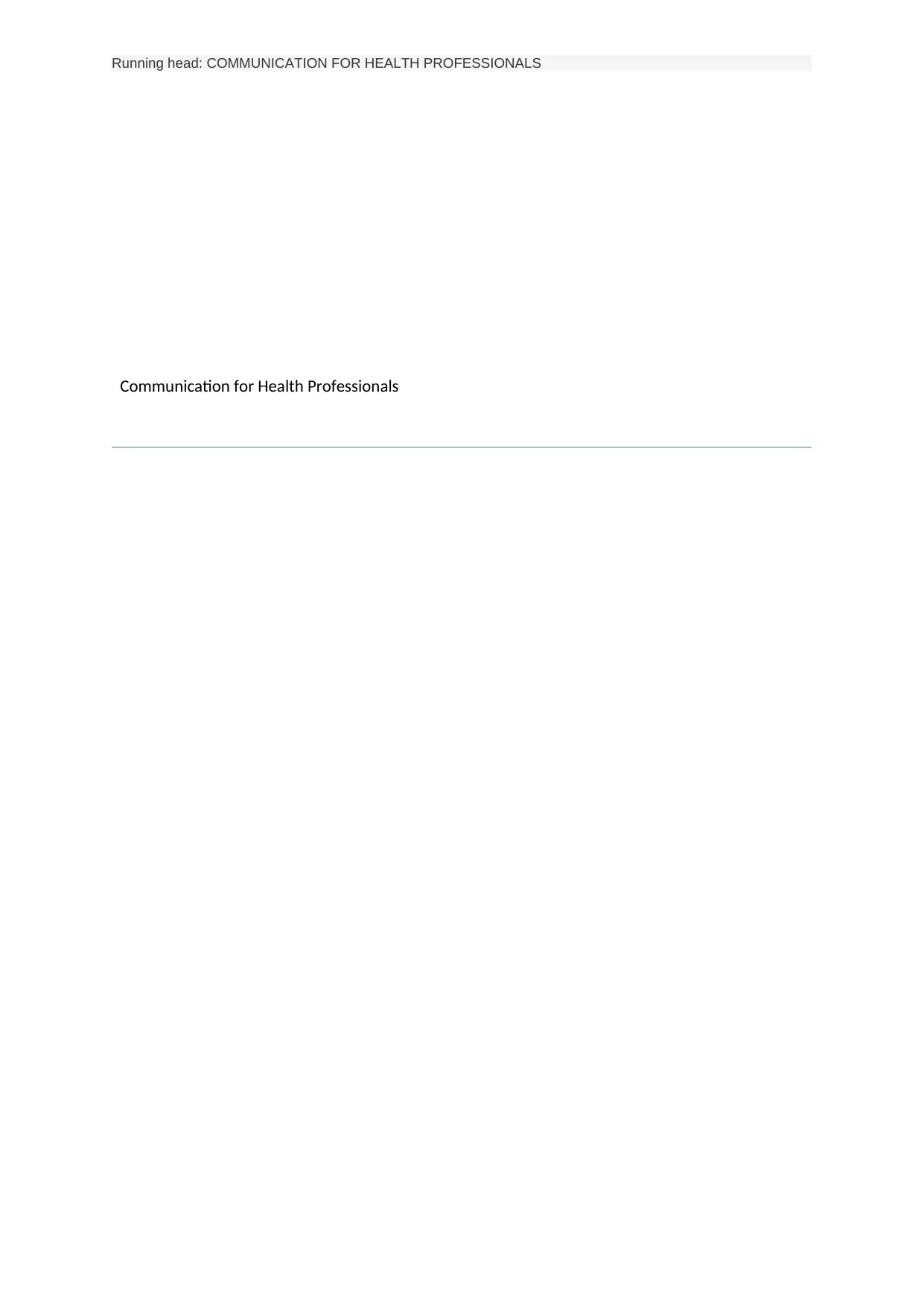
Running head: COMMUNICATION FOR HEALTH PROFESSIONALS
Communication for Health Professionals
Communication for Health Professionals
Paraphrase This Document
Need a fresh take? Get an instant paraphrase of this document with our AI Paraphraser
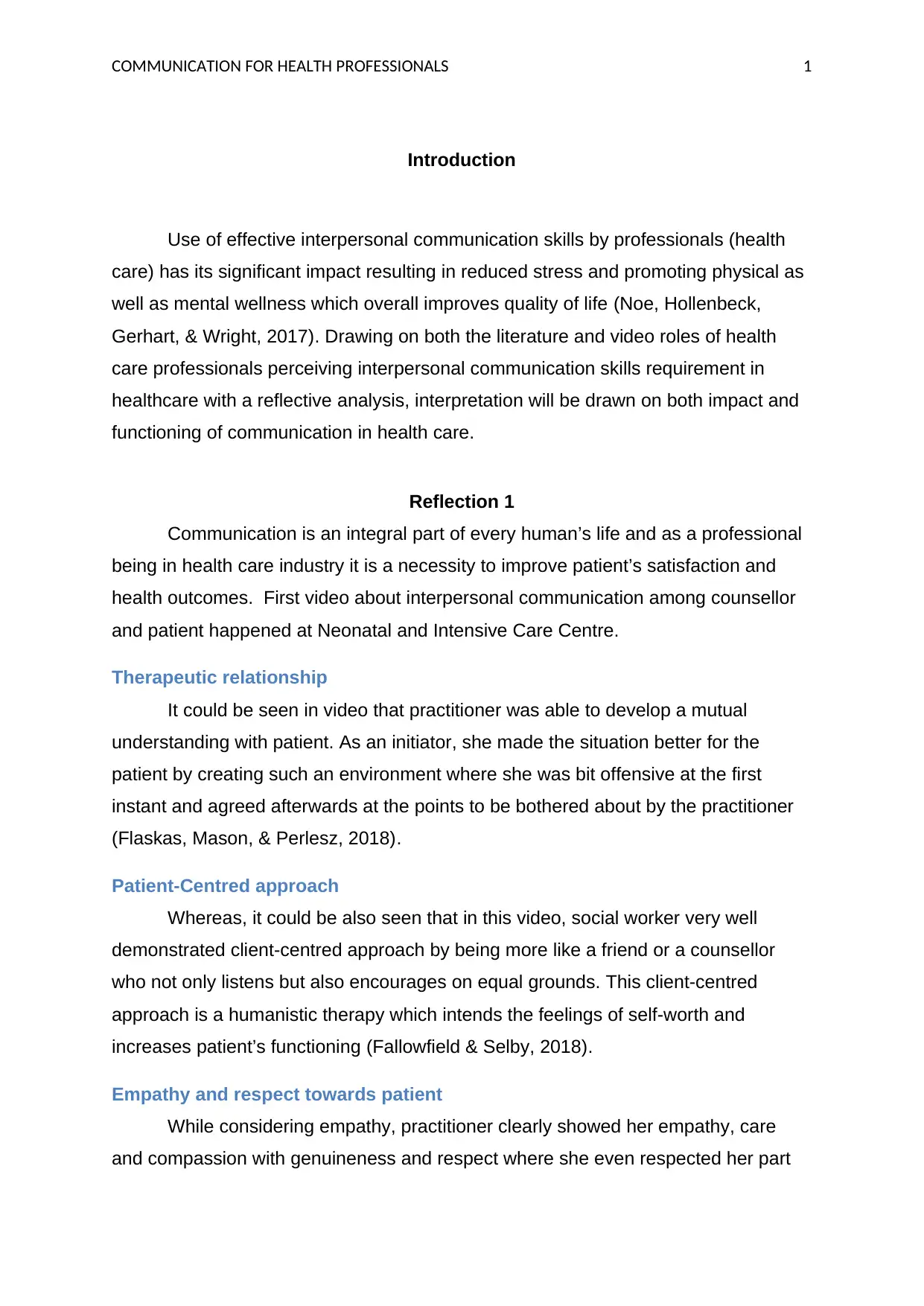
COMMUNICATION FOR HEALTH PROFESSIONALS 1
Introduction
Use of effective interpersonal communication skills by professionals (health
care) has its significant impact resulting in reduced stress and promoting physical as
well as mental wellness which overall improves quality of life (Noe, Hollenbeck,
Gerhart, & Wright, 2017). Drawing on both the literature and video roles of health
care professionals perceiving interpersonal communication skills requirement in
healthcare with a reflective analysis, interpretation will be drawn on both impact and
functioning of communication in health care.
Reflection 1
Communication is an integral part of every human’s life and as a professional
being in health care industry it is a necessity to improve patient’s satisfaction and
health outcomes. First video about interpersonal communication among counsellor
and patient happened at Neonatal and Intensive Care Centre.
Therapeutic relationship
It could be seen in video that practitioner was able to develop a mutual
understanding with patient. As an initiator, she made the situation better for the
patient by creating such an environment where she was bit offensive at the first
instant and agreed afterwards at the points to be bothered about by the practitioner
(Flaskas, Mason, & Perlesz, 2018).
Patient-Centred approach
Whereas, it could be also seen that in this video, social worker very well
demonstrated client-centred approach by being more like a friend or a counsellor
who not only listens but also encourages on equal grounds. This client-centred
approach is a humanistic therapy which intends the feelings of self-worth and
increases patient’s functioning (Fallowfield & Selby, 2018).
Empathy and respect towards patient
While considering empathy, practitioner clearly showed her empathy, care
and compassion with genuineness and respect where she even respected her part
Introduction
Use of effective interpersonal communication skills by professionals (health
care) has its significant impact resulting in reduced stress and promoting physical as
well as mental wellness which overall improves quality of life (Noe, Hollenbeck,
Gerhart, & Wright, 2017). Drawing on both the literature and video roles of health
care professionals perceiving interpersonal communication skills requirement in
healthcare with a reflective analysis, interpretation will be drawn on both impact and
functioning of communication in health care.
Reflection 1
Communication is an integral part of every human’s life and as a professional
being in health care industry it is a necessity to improve patient’s satisfaction and
health outcomes. First video about interpersonal communication among counsellor
and patient happened at Neonatal and Intensive Care Centre.
Therapeutic relationship
It could be seen in video that practitioner was able to develop a mutual
understanding with patient. As an initiator, she made the situation better for the
patient by creating such an environment where she was bit offensive at the first
instant and agreed afterwards at the points to be bothered about by the practitioner
(Flaskas, Mason, & Perlesz, 2018).
Patient-Centred approach
Whereas, it could be also seen that in this video, social worker very well
demonstrated client-centred approach by being more like a friend or a counsellor
who not only listens but also encourages on equal grounds. This client-centred
approach is a humanistic therapy which intends the feelings of self-worth and
increases patient’s functioning (Fallowfield & Selby, 2018).
Empathy and respect towards patient
While considering empathy, practitioner clearly showed her empathy, care
and compassion with genuineness and respect where she even respected her part
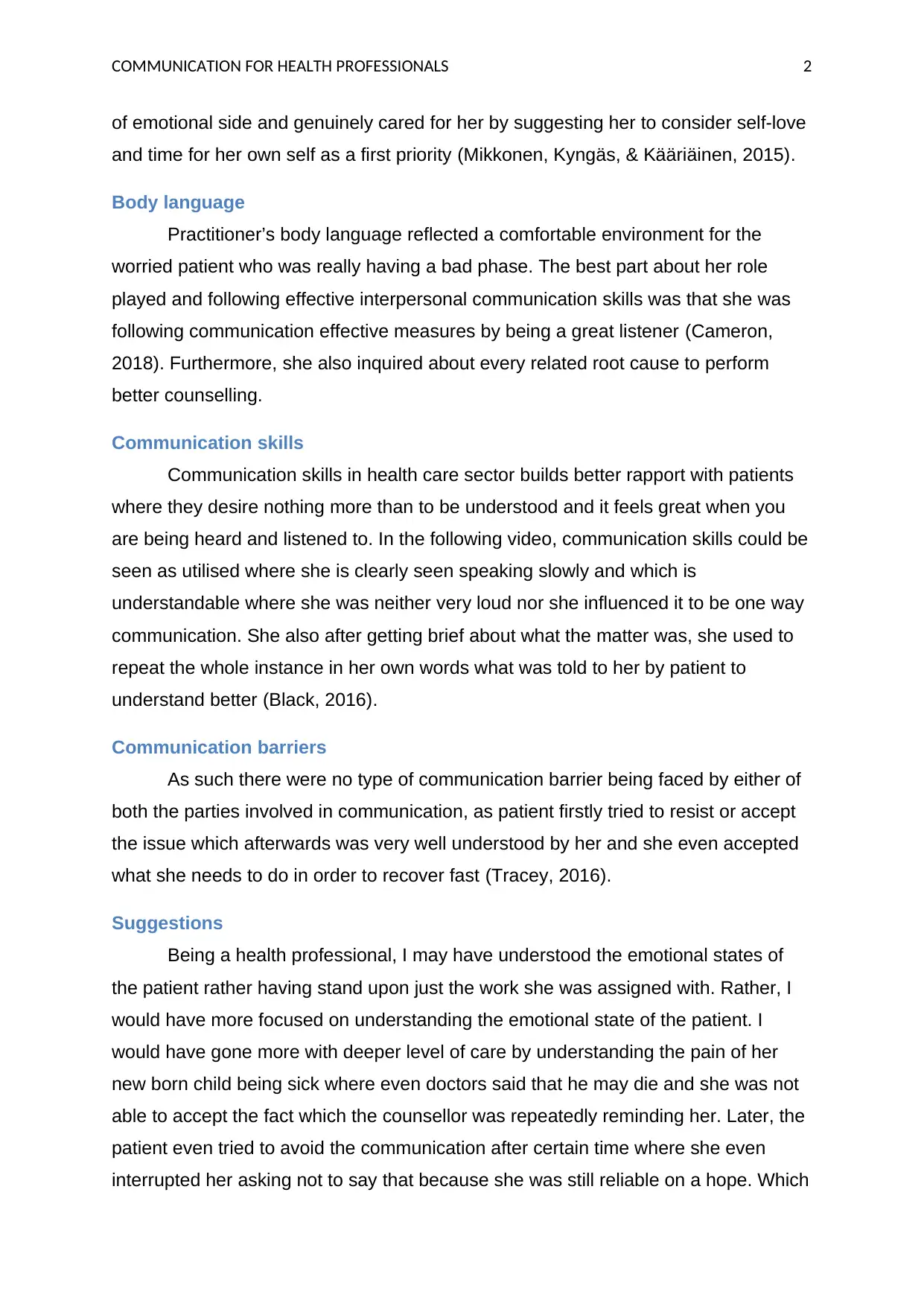
COMMUNICATION FOR HEALTH PROFESSIONALS 2
of emotional side and genuinely cared for her by suggesting her to consider self-love
and time for her own self as a first priority (Mikkonen, Kyngäs, & Kääriäinen, 2015).
Body language
Practitioner’s body language reflected a comfortable environment for the
worried patient who was really having a bad phase. The best part about her role
played and following effective interpersonal communication skills was that she was
following communication effective measures by being a great listener (Cameron,
2018). Furthermore, she also inquired about every related root cause to perform
better counselling.
Communication skills
Communication skills in health care sector builds better rapport with patients
where they desire nothing more than to be understood and it feels great when you
are being heard and listened to. In the following video, communication skills could be
seen as utilised where she is clearly seen speaking slowly and which is
understandable where she was neither very loud nor she influenced it to be one way
communication. She also after getting brief about what the matter was, she used to
repeat the whole instance in her own words what was told to her by patient to
understand better (Black, 2016).
Communication barriers
As such there were no type of communication barrier being faced by either of
both the parties involved in communication, as patient firstly tried to resist or accept
the issue which afterwards was very well understood by her and she even accepted
what she needs to do in order to recover fast (Tracey, 2016).
Suggestions
Being a health professional, I may have understood the emotional states of
the patient rather having stand upon just the work she was assigned with. Rather, I
would have more focused on understanding the emotional state of the patient. I
would have gone more with deeper level of care by understanding the pain of her
new born child being sick where even doctors said that he may die and she was not
able to accept the fact which the counsellor was repeatedly reminding her. Later, the
patient even tried to avoid the communication after certain time where she even
interrupted her asking not to say that because she was still reliable on a hope. Which
of emotional side and genuinely cared for her by suggesting her to consider self-love
and time for her own self as a first priority (Mikkonen, Kyngäs, & Kääriäinen, 2015).
Body language
Practitioner’s body language reflected a comfortable environment for the
worried patient who was really having a bad phase. The best part about her role
played and following effective interpersonal communication skills was that she was
following communication effective measures by being a great listener (Cameron,
2018). Furthermore, she also inquired about every related root cause to perform
better counselling.
Communication skills
Communication skills in health care sector builds better rapport with patients
where they desire nothing more than to be understood and it feels great when you
are being heard and listened to. In the following video, communication skills could be
seen as utilised where she is clearly seen speaking slowly and which is
understandable where she was neither very loud nor she influenced it to be one way
communication. She also after getting brief about what the matter was, she used to
repeat the whole instance in her own words what was told to her by patient to
understand better (Black, 2016).
Communication barriers
As such there were no type of communication barrier being faced by either of
both the parties involved in communication, as patient firstly tried to resist or accept
the issue which afterwards was very well understood by her and she even accepted
what she needs to do in order to recover fast (Tracey, 2016).
Suggestions
Being a health professional, I may have understood the emotional states of
the patient rather having stand upon just the work she was assigned with. Rather, I
would have more focused on understanding the emotional state of the patient. I
would have gone more with deeper level of care by understanding the pain of her
new born child being sick where even doctors said that he may die and she was not
able to accept the fact which the counsellor was repeatedly reminding her. Later, the
patient even tried to avoid the communication after certain time where she even
interrupted her asking not to say that because she was still reliable on a hope. Which
⊘ This is a preview!⊘
Do you want full access?
Subscribe today to unlock all pages.

Trusted by 1+ million students worldwide
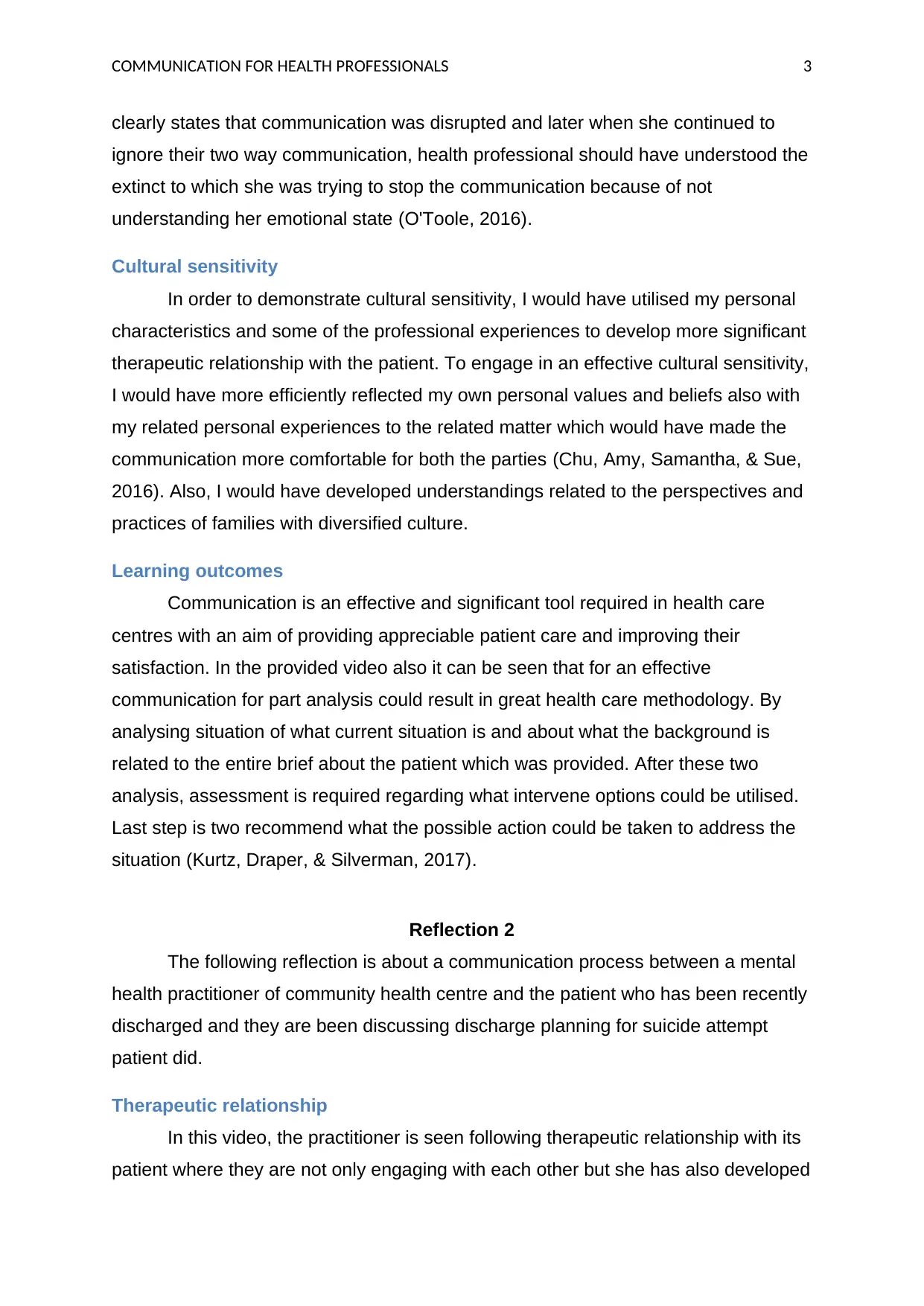
COMMUNICATION FOR HEALTH PROFESSIONALS 3
clearly states that communication was disrupted and later when she continued to
ignore their two way communication, health professional should have understood the
extinct to which she was trying to stop the communication because of not
understanding her emotional state (O'Toole, 2016).
Cultural sensitivity
In order to demonstrate cultural sensitivity, I would have utilised my personal
characteristics and some of the professional experiences to develop more significant
therapeutic relationship with the patient. To engage in an effective cultural sensitivity,
I would have more efficiently reflected my own personal values and beliefs also with
my related personal experiences to the related matter which would have made the
communication more comfortable for both the parties (Chu, Amy, Samantha, & Sue,
2016). Also, I would have developed understandings related to the perspectives and
practices of families with diversified culture.
Learning outcomes
Communication is an effective and significant tool required in health care
centres with an aim of providing appreciable patient care and improving their
satisfaction. In the provided video also it can be seen that for an effective
communication for part analysis could result in great health care methodology. By
analysing situation of what current situation is and about what the background is
related to the entire brief about the patient which was provided. After these two
analysis, assessment is required regarding what intervene options could be utilised.
Last step is two recommend what the possible action could be taken to address the
situation (Kurtz, Draper, & Silverman, 2017).
Reflection 2
The following reflection is about a communication process between a mental
health practitioner of community health centre and the patient who has been recently
discharged and they are been discussing discharge planning for suicide attempt
patient did.
Therapeutic relationship
In this video, the practitioner is seen following therapeutic relationship with its
patient where they are not only engaging with each other but she has also developed
clearly states that communication was disrupted and later when she continued to
ignore their two way communication, health professional should have understood the
extinct to which she was trying to stop the communication because of not
understanding her emotional state (O'Toole, 2016).
Cultural sensitivity
In order to demonstrate cultural sensitivity, I would have utilised my personal
characteristics and some of the professional experiences to develop more significant
therapeutic relationship with the patient. To engage in an effective cultural sensitivity,
I would have more efficiently reflected my own personal values and beliefs also with
my related personal experiences to the related matter which would have made the
communication more comfortable for both the parties (Chu, Amy, Samantha, & Sue,
2016). Also, I would have developed understandings related to the perspectives and
practices of families with diversified culture.
Learning outcomes
Communication is an effective and significant tool required in health care
centres with an aim of providing appreciable patient care and improving their
satisfaction. In the provided video also it can be seen that for an effective
communication for part analysis could result in great health care methodology. By
analysing situation of what current situation is and about what the background is
related to the entire brief about the patient which was provided. After these two
analysis, assessment is required regarding what intervene options could be utilised.
Last step is two recommend what the possible action could be taken to address the
situation (Kurtz, Draper, & Silverman, 2017).
Reflection 2
The following reflection is about a communication process between a mental
health practitioner of community health centre and the patient who has been recently
discharged and they are been discussing discharge planning for suicide attempt
patient did.
Therapeutic relationship
In this video, the practitioner is seen following therapeutic relationship with its
patient where they are not only engaging with each other but she has also developed
Paraphrase This Document
Need a fresh take? Get an instant paraphrase of this document with our AI Paraphraser
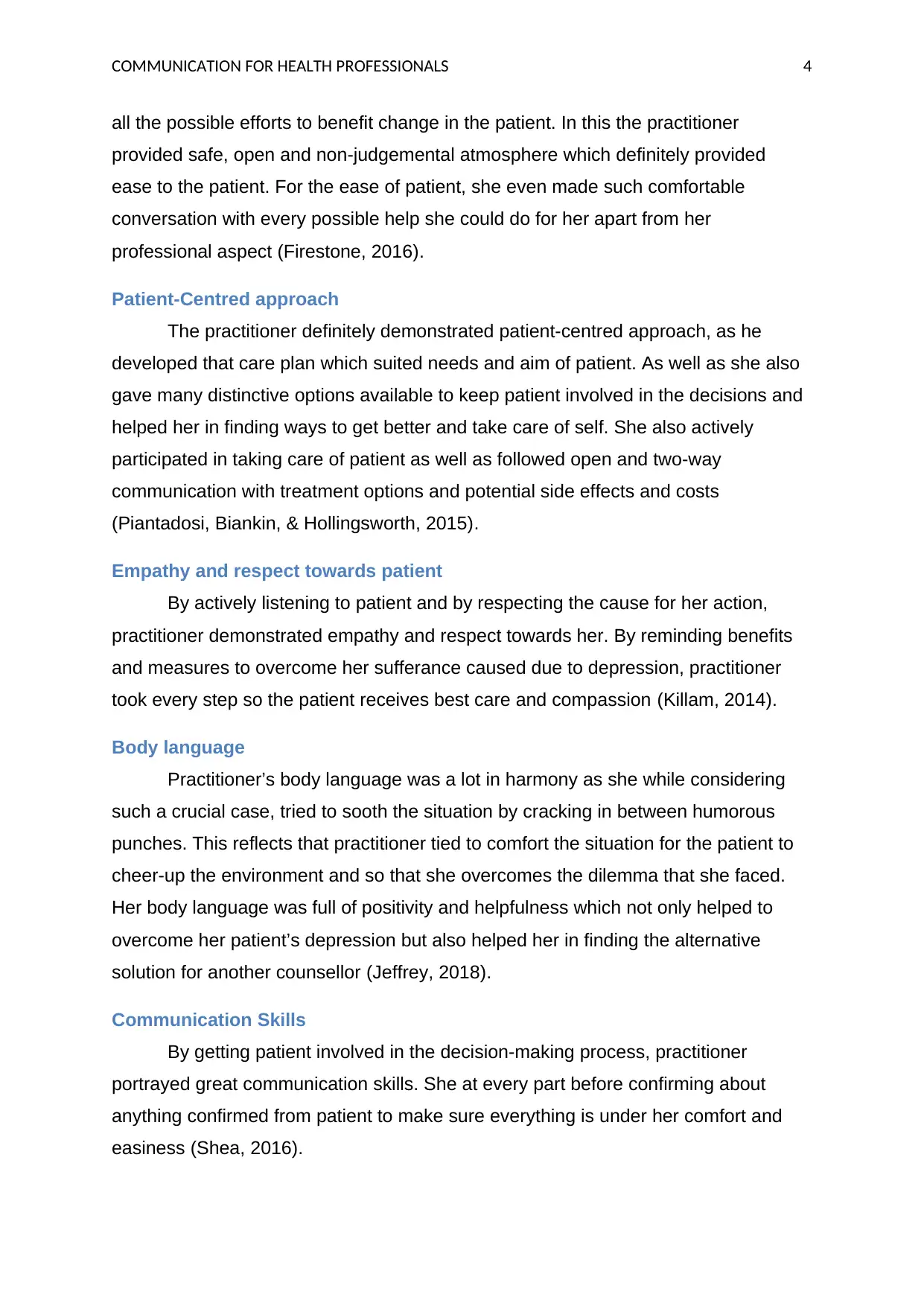
COMMUNICATION FOR HEALTH PROFESSIONALS 4
all the possible efforts to benefit change in the patient. In this the practitioner
provided safe, open and non-judgemental atmosphere which definitely provided
ease to the patient. For the ease of patient, she even made such comfortable
conversation with every possible help she could do for her apart from her
professional aspect (Firestone, 2016).
Patient-Centred approach
The practitioner definitely demonstrated patient-centred approach, as he
developed that care plan which suited needs and aim of patient. As well as she also
gave many distinctive options available to keep patient involved in the decisions and
helped her in finding ways to get better and take care of self. She also actively
participated in taking care of patient as well as followed open and two-way
communication with treatment options and potential side effects and costs
(Piantadosi, Biankin, & Hollingsworth, 2015).
Empathy and respect towards patient
By actively listening to patient and by respecting the cause for her action,
practitioner demonstrated empathy and respect towards her. By reminding benefits
and measures to overcome her sufferance caused due to depression, practitioner
took every step so the patient receives best care and compassion (Killam, 2014).
Body language
Practitioner’s body language was a lot in harmony as she while considering
such a crucial case, tried to sooth the situation by cracking in between humorous
punches. This reflects that practitioner tied to comfort the situation for the patient to
cheer-up the environment and so that she overcomes the dilemma that she faced.
Her body language was full of positivity and helpfulness which not only helped to
overcome her patient’s depression but also helped her in finding the alternative
solution for another counsellor (Jeffrey, 2018).
Communication Skills
By getting patient involved in the decision-making process, practitioner
portrayed great communication skills. She at every part before confirming about
anything confirmed from patient to make sure everything is under her comfort and
easiness (Shea, 2016).
all the possible efforts to benefit change in the patient. In this the practitioner
provided safe, open and non-judgemental atmosphere which definitely provided
ease to the patient. For the ease of patient, she even made such comfortable
conversation with every possible help she could do for her apart from her
professional aspect (Firestone, 2016).
Patient-Centred approach
The practitioner definitely demonstrated patient-centred approach, as he
developed that care plan which suited needs and aim of patient. As well as she also
gave many distinctive options available to keep patient involved in the decisions and
helped her in finding ways to get better and take care of self. She also actively
participated in taking care of patient as well as followed open and two-way
communication with treatment options and potential side effects and costs
(Piantadosi, Biankin, & Hollingsworth, 2015).
Empathy and respect towards patient
By actively listening to patient and by respecting the cause for her action,
practitioner demonstrated empathy and respect towards her. By reminding benefits
and measures to overcome her sufferance caused due to depression, practitioner
took every step so the patient receives best care and compassion (Killam, 2014).
Body language
Practitioner’s body language was a lot in harmony as she while considering
such a crucial case, tried to sooth the situation by cracking in between humorous
punches. This reflects that practitioner tied to comfort the situation for the patient to
cheer-up the environment and so that she overcomes the dilemma that she faced.
Her body language was full of positivity and helpfulness which not only helped to
overcome her patient’s depression but also helped her in finding the alternative
solution for another counsellor (Jeffrey, 2018).
Communication Skills
By getting patient involved in the decision-making process, practitioner
portrayed great communication skills. She at every part before confirming about
anything confirmed from patient to make sure everything is under her comfort and
easiness (Shea, 2016).
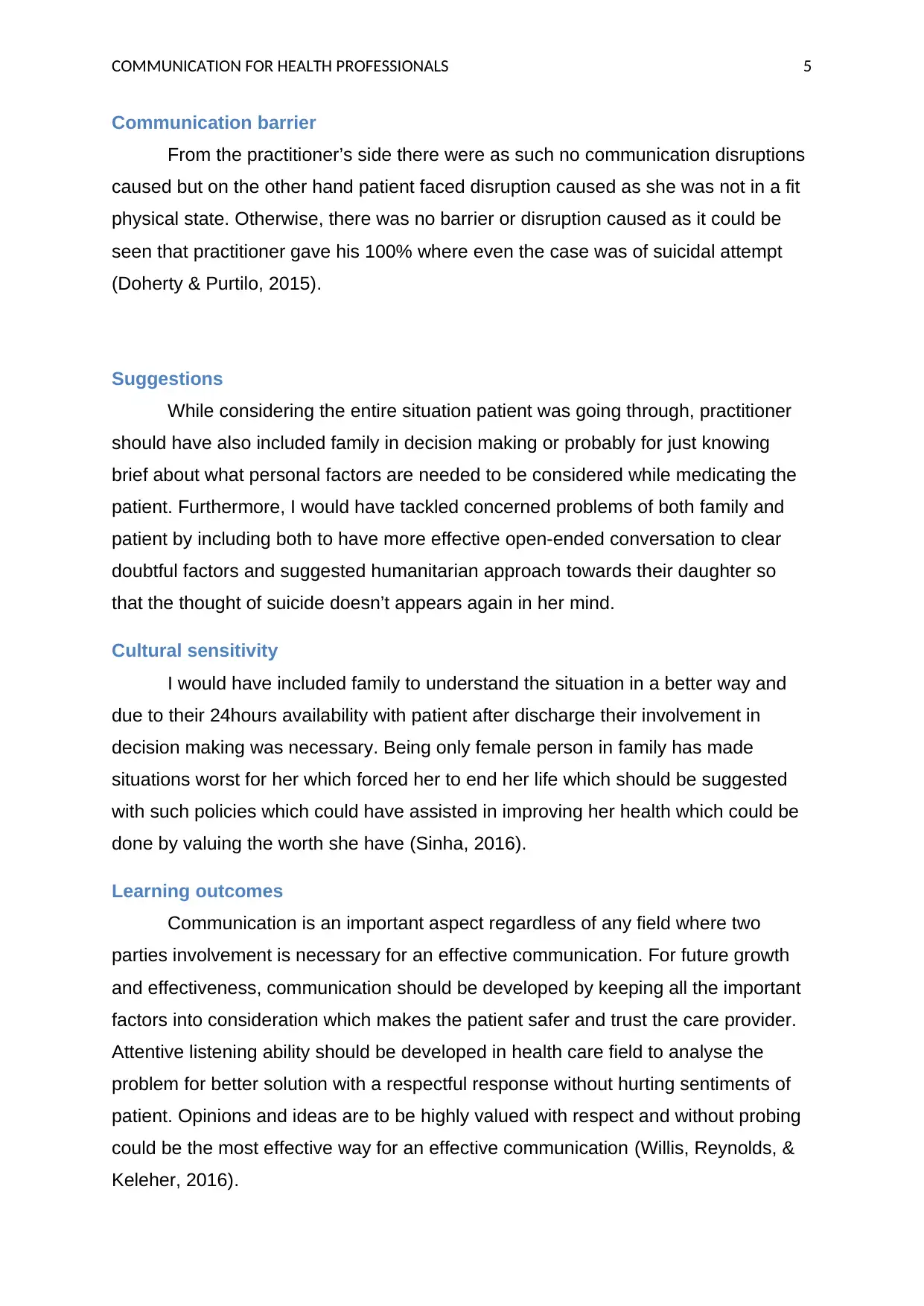
COMMUNICATION FOR HEALTH PROFESSIONALS 5
Communication barrier
From the practitioner’s side there were as such no communication disruptions
caused but on the other hand patient faced disruption caused as she was not in a fit
physical state. Otherwise, there was no barrier or disruption caused as it could be
seen that practitioner gave his 100% where even the case was of suicidal attempt
(Doherty & Purtilo, 2015).
Suggestions
While considering the entire situation patient was going through, practitioner
should have also included family in decision making or probably for just knowing
brief about what personal factors are needed to be considered while medicating the
patient. Furthermore, I would have tackled concerned problems of both family and
patient by including both to have more effective open-ended conversation to clear
doubtful factors and suggested humanitarian approach towards their daughter so
that the thought of suicide doesn’t appears again in her mind.
Cultural sensitivity
I would have included family to understand the situation in a better way and
due to their 24hours availability with patient after discharge their involvement in
decision making was necessary. Being only female person in family has made
situations worst for her which forced her to end her life which should be suggested
with such policies which could have assisted in improving her health which could be
done by valuing the worth she have (Sinha, 2016).
Learning outcomes
Communication is an important aspect regardless of any field where two
parties involvement is necessary for an effective communication. For future growth
and effectiveness, communication should be developed by keeping all the important
factors into consideration which makes the patient safer and trust the care provider.
Attentive listening ability should be developed in health care field to analyse the
problem for better solution with a respectful response without hurting sentiments of
patient. Opinions and ideas are to be highly valued with respect and without probing
could be the most effective way for an effective communication (Willis, Reynolds, &
Keleher, 2016).
Communication barrier
From the practitioner’s side there were as such no communication disruptions
caused but on the other hand patient faced disruption caused as she was not in a fit
physical state. Otherwise, there was no barrier or disruption caused as it could be
seen that practitioner gave his 100% where even the case was of suicidal attempt
(Doherty & Purtilo, 2015).
Suggestions
While considering the entire situation patient was going through, practitioner
should have also included family in decision making or probably for just knowing
brief about what personal factors are needed to be considered while medicating the
patient. Furthermore, I would have tackled concerned problems of both family and
patient by including both to have more effective open-ended conversation to clear
doubtful factors and suggested humanitarian approach towards their daughter so
that the thought of suicide doesn’t appears again in her mind.
Cultural sensitivity
I would have included family to understand the situation in a better way and
due to their 24hours availability with patient after discharge their involvement in
decision making was necessary. Being only female person in family has made
situations worst for her which forced her to end her life which should be suggested
with such policies which could have assisted in improving her health which could be
done by valuing the worth she have (Sinha, 2016).
Learning outcomes
Communication is an important aspect regardless of any field where two
parties involvement is necessary for an effective communication. For future growth
and effectiveness, communication should be developed by keeping all the important
factors into consideration which makes the patient safer and trust the care provider.
Attentive listening ability should be developed in health care field to analyse the
problem for better solution with a respectful response without hurting sentiments of
patient. Opinions and ideas are to be highly valued with respect and without probing
could be the most effective way for an effective communication (Willis, Reynolds, &
Keleher, 2016).
⊘ This is a preview!⊘
Do you want full access?
Subscribe today to unlock all pages.

Trusted by 1+ million students worldwide
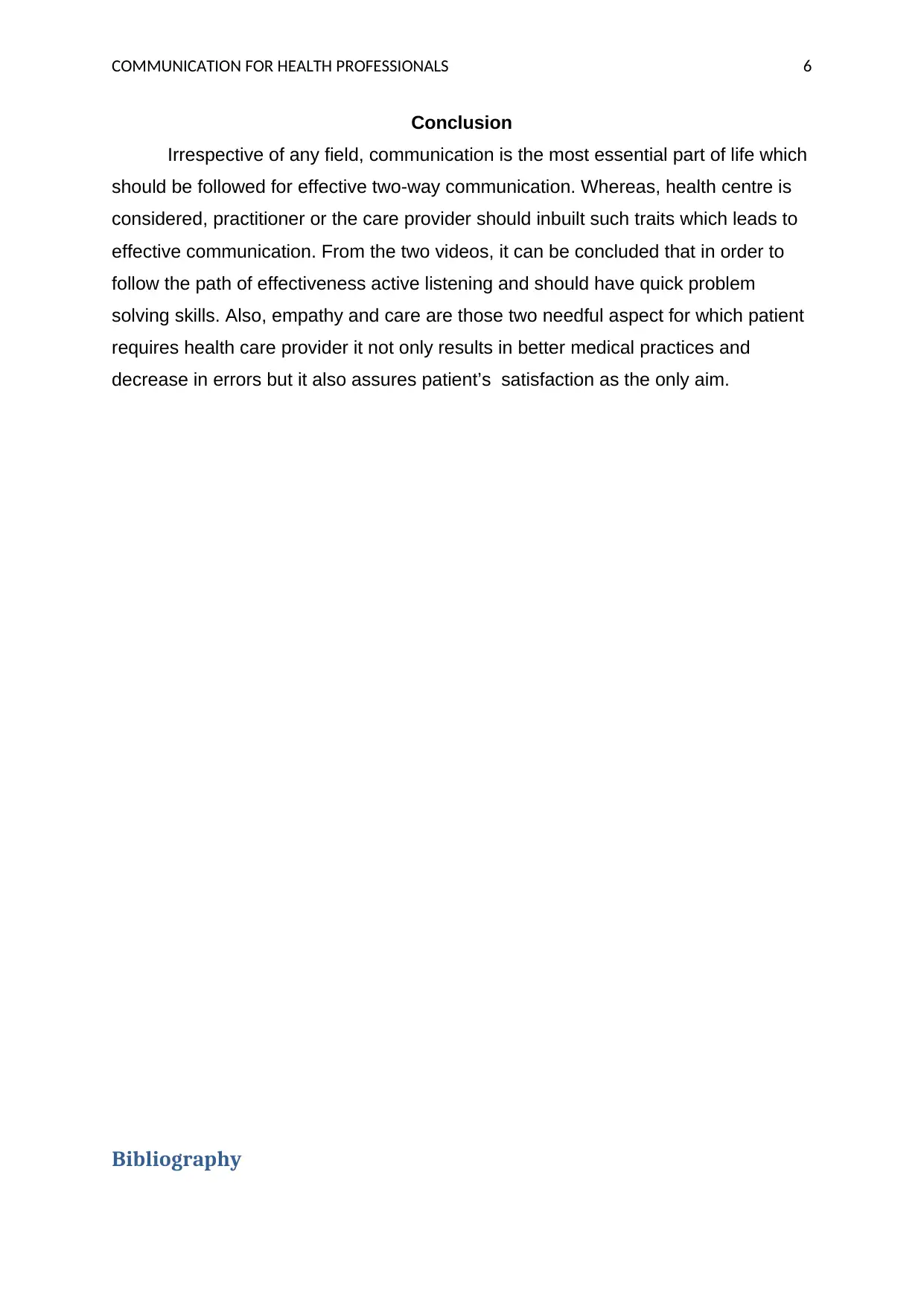
COMMUNICATION FOR HEALTH PROFESSIONALS 6
Conclusion
Irrespective of any field, communication is the most essential part of life which
should be followed for effective two-way communication. Whereas, health centre is
considered, practitioner or the care provider should inbuilt such traits which leads to
effective communication. From the two videos, it can be concluded that in order to
follow the path of effectiveness active listening and should have quick problem
solving skills. Also, empathy and care are those two needful aspect for which patient
requires health care provider it not only results in better medical practices and
decrease in errors but it also assures patient’s satisfaction as the only aim.
Bibliography
Conclusion
Irrespective of any field, communication is the most essential part of life which
should be followed for effective two-way communication. Whereas, health centre is
considered, practitioner or the care provider should inbuilt such traits which leads to
effective communication. From the two videos, it can be concluded that in order to
follow the path of effectiveness active listening and should have quick problem
solving skills. Also, empathy and care are those two needful aspect for which patient
requires health care provider it not only results in better medical practices and
decrease in errors but it also assures patient’s satisfaction as the only aim.
Bibliography
Paraphrase This Document
Need a fresh take? Get an instant paraphrase of this document with our AI Paraphraser
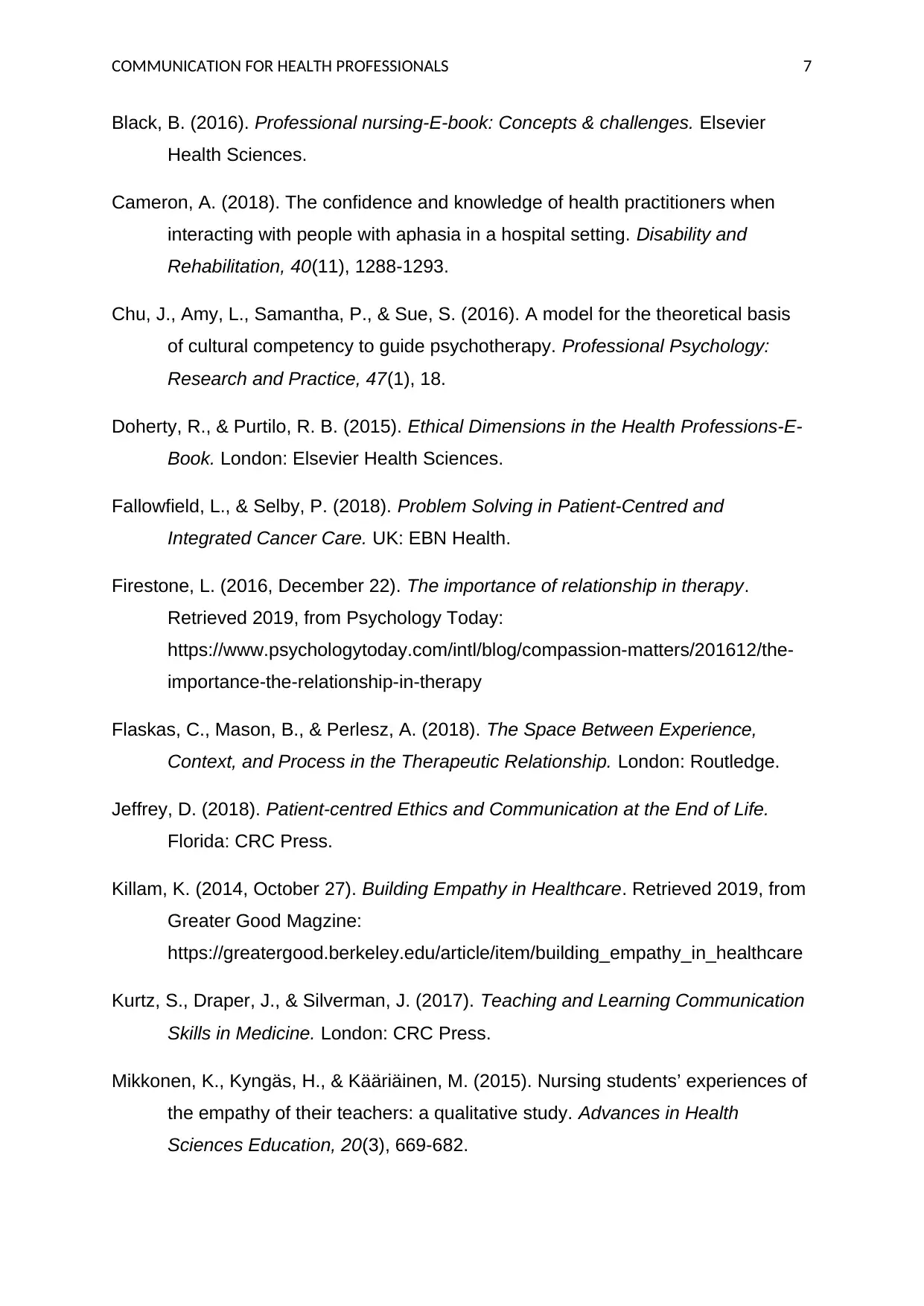
COMMUNICATION FOR HEALTH PROFESSIONALS 7
Black, B. (2016). Professional nursing-E-book: Concepts & challenges. Elsevier
Health Sciences.
Cameron, A. (2018). The confidence and knowledge of health practitioners when
interacting with people with aphasia in a hospital setting. Disability and
Rehabilitation, 40(11), 1288-1293.
Chu, J., Amy, L., Samantha, P., & Sue, S. (2016). A model for the theoretical basis
of cultural competency to guide psychotherapy. Professional Psychology:
Research and Practice, 47(1), 18.
Doherty, R., & Purtilo, R. B. (2015). Ethical Dimensions in the Health Professions-E-
Book. London: Elsevier Health Sciences.
Fallowfield, L., & Selby, P. (2018). Problem Solving in Patient-Centred and
Integrated Cancer Care. UK: EBN Health.
Firestone, L. (2016, December 22). The importance of relationship in therapy.
Retrieved 2019, from Psychology Today:
https://www.psychologytoday.com/intl/blog/compassion-matters/201612/the-
importance-the-relationship-in-therapy
Flaskas, C., Mason, B., & Perlesz, A. (2018). The Space Between Experience,
Context, and Process in the Therapeutic Relationship. London: Routledge.
Jeffrey, D. (2018). Patient-centred Ethics and Communication at the End of Life.
Florida: CRC Press.
Killam, K. (2014, October 27). Building Empathy in Healthcare. Retrieved 2019, from
Greater Good Magzine:
https://greatergood.berkeley.edu/article/item/building_empathy_in_healthcare
Kurtz, S., Draper, J., & Silverman, J. (2017). Teaching and Learning Communication
Skills in Medicine. London: CRC Press.
Mikkonen, K., Kyngäs, H., & Kääriäinen, M. (2015). Nursing students’ experiences of
the empathy of their teachers: a qualitative study. Advances in Health
Sciences Education, 20(3), 669-682.
Black, B. (2016). Professional nursing-E-book: Concepts & challenges. Elsevier
Health Sciences.
Cameron, A. (2018). The confidence and knowledge of health practitioners when
interacting with people with aphasia in a hospital setting. Disability and
Rehabilitation, 40(11), 1288-1293.
Chu, J., Amy, L., Samantha, P., & Sue, S. (2016). A model for the theoretical basis
of cultural competency to guide psychotherapy. Professional Psychology:
Research and Practice, 47(1), 18.
Doherty, R., & Purtilo, R. B. (2015). Ethical Dimensions in the Health Professions-E-
Book. London: Elsevier Health Sciences.
Fallowfield, L., & Selby, P. (2018). Problem Solving in Patient-Centred and
Integrated Cancer Care. UK: EBN Health.
Firestone, L. (2016, December 22). The importance of relationship in therapy.
Retrieved 2019, from Psychology Today:
https://www.psychologytoday.com/intl/blog/compassion-matters/201612/the-
importance-the-relationship-in-therapy
Flaskas, C., Mason, B., & Perlesz, A. (2018). The Space Between Experience,
Context, and Process in the Therapeutic Relationship. London: Routledge.
Jeffrey, D. (2018). Patient-centred Ethics and Communication at the End of Life.
Florida: CRC Press.
Killam, K. (2014, October 27). Building Empathy in Healthcare. Retrieved 2019, from
Greater Good Magzine:
https://greatergood.berkeley.edu/article/item/building_empathy_in_healthcare
Kurtz, S., Draper, J., & Silverman, J. (2017). Teaching and Learning Communication
Skills in Medicine. London: CRC Press.
Mikkonen, K., Kyngäs, H., & Kääriäinen, M. (2015). Nursing students’ experiences of
the empathy of their teachers: a qualitative study. Advances in Health
Sciences Education, 20(3), 669-682.
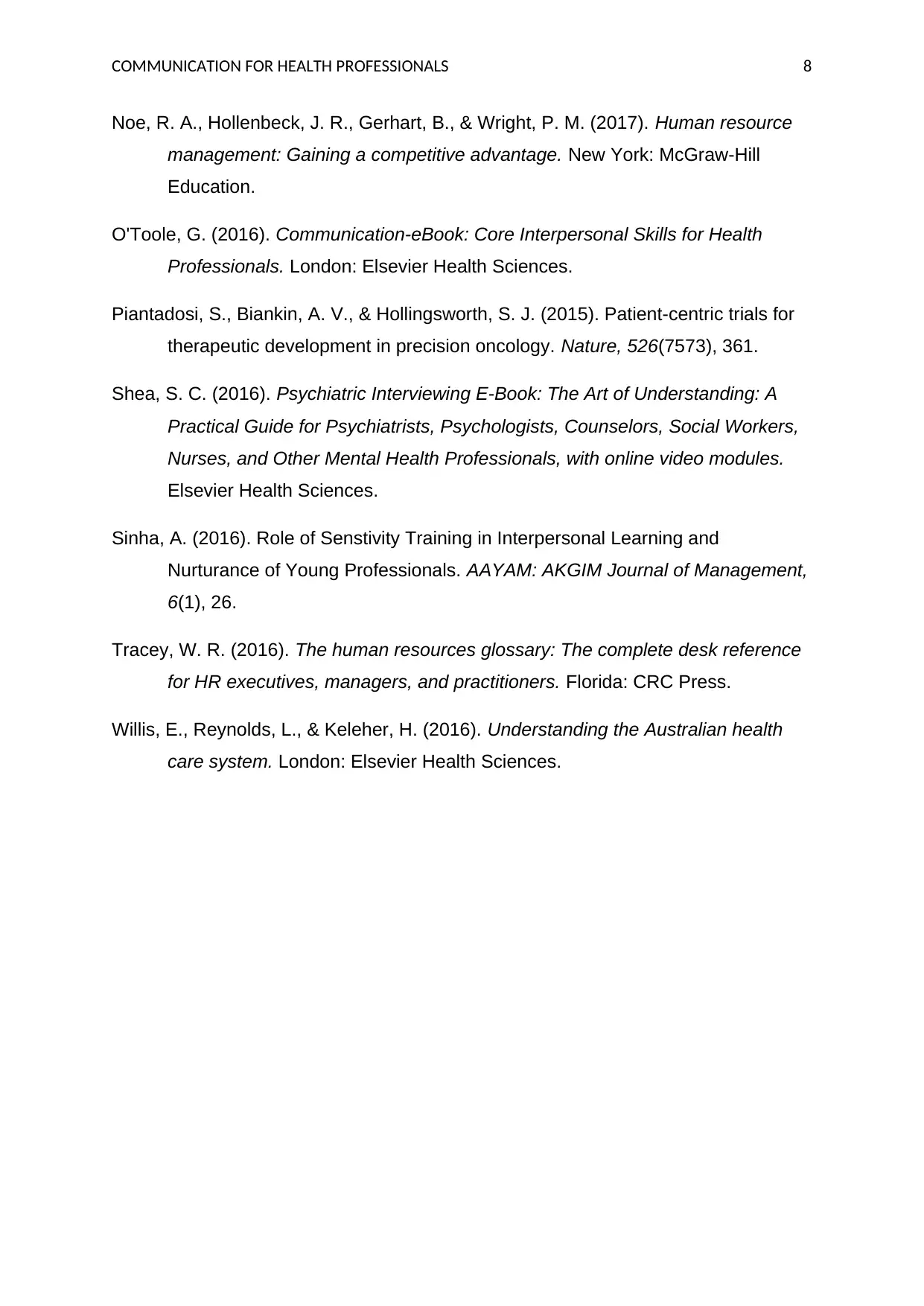
COMMUNICATION FOR HEALTH PROFESSIONALS 8
Noe, R. A., Hollenbeck, J. R., Gerhart, B., & Wright, P. M. (2017). Human resource
management: Gaining a competitive advantage. New York: McGraw-Hill
Education.
O'Toole, G. (2016). Communication-eBook: Core Interpersonal Skills for Health
Professionals. London: Elsevier Health Sciences.
Piantadosi, S., Biankin, A. V., & Hollingsworth, S. J. (2015). Patient-centric trials for
therapeutic development in precision oncology. Nature, 526(7573), 361.
Shea, S. C. (2016). Psychiatric Interviewing E-Book: The Art of Understanding: A
Practical Guide for Psychiatrists, Psychologists, Counselors, Social Workers,
Nurses, and Other Mental Health Professionals, with online video modules.
Elsevier Health Sciences.
Sinha, A. (2016). Role of Senstivity Training in Interpersonal Learning and
Nurturance of Young Professionals. AAYAM: AKGIM Journal of Management,
6(1), 26.
Tracey, W. R. (2016). The human resources glossary: The complete desk reference
for HR executives, managers, and practitioners. Florida: CRC Press.
Willis, E., Reynolds, L., & Keleher, H. (2016). Understanding the Australian health
care system. London: Elsevier Health Sciences.
Noe, R. A., Hollenbeck, J. R., Gerhart, B., & Wright, P. M. (2017). Human resource
management: Gaining a competitive advantage. New York: McGraw-Hill
Education.
O'Toole, G. (2016). Communication-eBook: Core Interpersonal Skills for Health
Professionals. London: Elsevier Health Sciences.
Piantadosi, S., Biankin, A. V., & Hollingsworth, S. J. (2015). Patient-centric trials for
therapeutic development in precision oncology. Nature, 526(7573), 361.
Shea, S. C. (2016). Psychiatric Interviewing E-Book: The Art of Understanding: A
Practical Guide for Psychiatrists, Psychologists, Counselors, Social Workers,
Nurses, and Other Mental Health Professionals, with online video modules.
Elsevier Health Sciences.
Sinha, A. (2016). Role of Senstivity Training in Interpersonal Learning and
Nurturance of Young Professionals. AAYAM: AKGIM Journal of Management,
6(1), 26.
Tracey, W. R. (2016). The human resources glossary: The complete desk reference
for HR executives, managers, and practitioners. Florida: CRC Press.
Willis, E., Reynolds, L., & Keleher, H. (2016). Understanding the Australian health
care system. London: Elsevier Health Sciences.
⊘ This is a preview!⊘
Do you want full access?
Subscribe today to unlock all pages.

Trusted by 1+ million students worldwide
1 out of 9
Related Documents
Your All-in-One AI-Powered Toolkit for Academic Success.
+13062052269
info@desklib.com
Available 24*7 on WhatsApp / Email
![[object Object]](/_next/static/media/star-bottom.7253800d.svg)
Unlock your academic potential
Copyright © 2020–2025 A2Z Services. All Rights Reserved. Developed and managed by ZUCOL.





